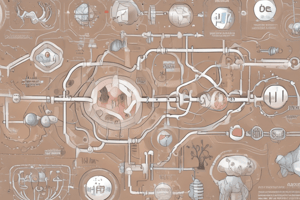Podcast
Questions and Answers
What is the primary role of amino acids during periods of starvation?
What is the primary role of amino acids during periods of starvation?
- They are converted to lipids for energy storage.
- They are used to replenish TCA cycle intermediates and gluconeogenesis. (correct)
- They are primarily stored for future use.
- They are solely excreted as waste without being utilized.
Which of the following describes the significance of amino acid oxidation?
Which of the following describes the significance of amino acid oxidation?
- It leads to the formation of stored fat.
- It increases the rate of protein synthesis.
- It is the primary source of energy during high-carbohydrate intake.
- It allows excess amino acids to be catabolized for fuel. (correct)
What is the main function of transamination in amino acid catabolism?
What is the main function of transamination in amino acid catabolism?
- To remove ammonia from amino acids.
- To transfer amino groups to keto acids. (correct)
- To synthesize non-essential amino acids from essential ones.
- To oxidize the carbon skeleton of amino acids.
Which enzyme is responsible for the oxidative deamination of glutamate?
Which enzyme is responsible for the oxidative deamination of glutamate?
What distinguishes amino acids from carbohydrates and fatty acids in terms of storage?
What distinguishes amino acids from carbohydrates and fatty acids in terms of storage?
Which process is NOT associated with the removal of ammonia from amino acids?
Which process is NOT associated with the removal of ammonia from amino acids?
What is the function of pyridoxal phosphate (PLP) in amino acid metabolism?
What is the function of pyridoxal phosphate (PLP) in amino acid metabolism?
Which statement about non-essential amino acids is correct?
Which statement about non-essential amino acids is correct?
What is the primary product of oxidative deamination of glutamine in the liver?
What is the primary product of oxidative deamination of glutamine in the liver?
Which enzyme is responsible for the conversion of ammonia and bicarbonate to carbamoyl phosphate in the liver?
Which enzyme is responsible for the conversion of ammonia and bicarbonate to carbamoyl phosphate in the liver?
In which compartment of the cell does the urea cycle primarily occur?
In which compartment of the cell does the urea cycle primarily occur?
Which of the following amino acids can be categorized as both glucogenic and ketogenic?
Which of the following amino acids can be categorized as both glucogenic and ketogenic?
Phenylketonuria is caused by a deficiency in which enzyme?
Phenylketonuria is caused by a deficiency in which enzyme?
Methionine is primarily involved in the biosynthesis of which compound?
Methionine is primarily involved in the biosynthesis of which compound?
Which amino acid is primarily degraded to oxaloacetate in the metabolic pathway?
Which amino acid is primarily degraded to oxaloacetate in the metabolic pathway?
What role does tetrahydrofolate (THF) play in amino acid metabolism?
What role does tetrahydrofolate (THF) play in amino acid metabolism?
Glucogenic amino acids are primarily degraded to which of the following?
Glucogenic amino acids are primarily degraded to which of the following?
Which branched-chain amino acid is degraded to succinyl-CoA?
Which branched-chain amino acid is degraded to succinyl-CoA?
What is an essential amino acid that cannot be synthesized by mammals?
What is an essential amino acid that cannot be synthesized by mammals?
Which of the following amino acids is not classified as glucogenic?
Which of the following amino acids is not classified as glucogenic?
What is the primary function of the nitrogen-fixing bacteria in legumes?
What is the primary function of the nitrogen-fixing bacteria in legumes?
Which compound is formed from the combination of ammonium and carbon dioxide in the liver?
Which compound is formed from the combination of ammonium and carbon dioxide in the liver?
Flashcards
Amino acid oxidation during starvation
Amino acid oxidation during starvation
During starvation, amino acids are converted to TCA cycle intermediates and used for gluconeogenesis to provide energy.
Amino acid catabolism in excess protein diet
Amino acid catabolism in excess protein diet
Excess amino acids from a high protein diet are broken down (oxidized) for energy.
Transamination role in amino acid catabolism
Transamination role in amino acid catabolism
Transamination is the first step for most amino acid breakdown, transferring an amino group from an amino acid to a keto acid.
Oxidative deamination of glutamate
Oxidative deamination of glutamate
Signup and view all the flashcards
Urea cycle role in ammonia removal
Urea cycle role in ammonia removal
Signup and view all the flashcards
Key difference between amino acid and other biomolecules (carbohydrates/fatty acids)
Key difference between amino acid and other biomolecules (carbohydrates/fatty acids)
Signup and view all the flashcards
Ammonia removal importance
Ammonia removal importance
Signup and view all the flashcards
Role of PLP in transamination
Role of PLP in transamination
Signup and view all the flashcards
Urea Cycle
Urea Cycle
Signup and view all the flashcards
Oxidative Deamination
Oxidative Deamination
Signup and view all the flashcards
Glucogenic Amino Acids
Glucogenic Amino Acids
Signup and view all the flashcards
Ketogenic Amino Acids
Ketogenic Amino Acids
Signup and view all the flashcards
Transamination
Transamination
Signup and view all the flashcards
Phenylketonuria (PKU)
Phenylketonuria (PKU)
Signup and view all the flashcards
Essential Amino Acids
Essential Amino Acids
Signup and view all the flashcards
Non-essential Amino Acids
Non-essential Amino Acids
Signup and view all the flashcards
Carbamoyl phosphate synthetase I
Carbamoyl phosphate synthetase I
Signup and view all the flashcards
Nitrogen Cycle
Nitrogen Cycle
Signup and view all the flashcards
Amino Acid Biosynthesis
Amino Acid Biosynthesis
Signup and view all the flashcards
Glutamate
Glutamate
Signup and view all the flashcards
Glutamine
Glutamine
Signup and view all the flashcards
Phenylalanine
Phenylalanine
Signup and view all the flashcards
Nitrogen Fixation
Nitrogen Fixation
Signup and view all the flashcards
Study Notes
Amino Acid Metabolism Learning Objectives
- Explain the significance of amino acid oxidation.
- Recognize the reaction steps for ammonia removal and the urea cycle (enzymes, metabolites, chemical changes, flow of carbon and nitrogen).
- Briefly understand the oxidation of carbon skeletons in various amino acids, noting the flow of carbon, nitrogen, and sulfur.
- Explain the significance of amino acid biosynthesis.
- Recognize the reaction steps for ammonia assimilation.
- Briefly understand the biosynthesis of non-essential amino acids, noting the flow of carbon, nitrogen, and sulfur.
Amino Acid Catabolism
- During starvation, amino acids replenish TCA cycle intermediates and serve as gluconeogenesis precursors.
- Organisms with high protein diets can oxidize excess amino acids as fuel.
- Excess amino acids are not stored; they are catabolized (oxidized).
- In animals, amino acids released from proteins are the major nitrogen sources.
- Amino acids differ from carbohydrates and fatty acids in their ability to be oxidized.
Removal of Amino Group from Amino Acids
- Amino acids are broken down to release ammonia (NH3)
- The carbon skeletons are converted into various metabolites, including glucose, acetyl-CoA, and ketone bodies.
- Urea is formed from ammonia to be excreted.
Transamination
- The initial step in the catabolism of most amino acids is transamination.
- A universal amino group acceptor is a-ketoglutarate.
- The reaction results in the formation of glutamate and an a-keto acid.
- The reaction is catalyzed by aminotransferases, often requiring pyridoxal phosphate (PLP).
Oxidative Deamination of Glutamate
- Glutamate dehydrogenase catalyzes the oxidative deamination of glutamate in the mitochondrial matrix.
- Oxidation results in the formation of a-ketoglutarate and ammonia (NH3).
- NAD(P)+ is reduced to NAD(P)H in the process.
Non-liver Tissues
- Glutamine synthetase converts glutamate to glutamine, which is transported in the bloodstream.
Glutamine Transport to Liver
- Glutaminase in the liver mitochondria converts glutamine back to glutamate.
- Oxidative deamination of glutamate releases ammonia (NH3).
Urea in Liver
- Ammonia is converted to urea via the urea cycle.
- This process takes place within the mitochondrial matrix.
The Urea Cycle
- The urea cycle involves several enzymatic steps, converting ammonia and carbon dioxide into urea.
- The urea cycle intermediates are crucial for the cycle to function.
- The cycle involves both mitochondrial and cytosolic processes.
Linkage between Urea Cycle and TCA Cycle
- There are connections between the urea cycle and the citric acid cycle.
- Fumarate, the intermediator, links the two cycles and is used in both (and in the production of amino acids, such as aspartate).
Metabolism of Carbon Skeleton
- The carbon skeleton from amino acids can be converted into various intermediary metabolites.
- These include glucose, acetyl-CoA, and ketone bodies.
- Ammonia is a byproduct.
Oxidation of Carbon Skeletons in Amino Acids
- Glucogenic amino acids are degraded to intermediates in the citric acid cycle (or their precursors).
- Ketogenic amino acids are degraded to acetyl-CoA or acetoacetate .
Specific Amino Acid Oxidation
- Alanine, cysteine, glycine, serine, and threonine are all oxidized to pyruvate.
- Isoleucine, leucine, and valine are transformed into acetyl-CoA or propionyl-CoA.
- Lysine degrades into acetoacetate.
Methionine Metabolism
- Methionine degradation leads to succinyl-CoA via propionyl-CoA.
- The cycle involves the recycling of a methyl group.
Leucine, Valine, Isoleucine
- Branched-chain amino acids are broken down to various intermediates that enter either the citric acid cycle or form acetyl-CoA, acetoacetate, or succinyl-CoA.
Lysine Degradation
- Lysine is degraded to acetoacetate.
- This involves transamination, decarboxylation steps, and the formation of intermediates like α-aminoadipate.
Tryptophan Degradation
- Tryptophan is degraded to acetoacetate and pyruvate,
Phenylalanine and Tyrosine Degradation
- Phenylalanine and tyrosine are degraded into acetoacetate and fumarate.
Phenylketonuria
- Phenylketonuria is a genetic disorder due to a defective phenylalanine hydroxylase.
- Phenylalanine accumulates and leads to the production of harmful metabolites.
Aspartame
- Aspartame is an artificial sweetener.
- It is a dipeptide containing phenylalanine.
Amino Acid Biosynthesis
- The nitrogen cycle involves nitrogen fixation (converting atmospheric N2 to NH3).
- Various bacteria, fungi, and plants use nitrogenase to perform this process
- Plants use the ammonia to make amino acids
Synthesis of Essential and Non-Essential Amino Acids
- List of essential and non-essential amino acids, including their related precursors.
Biosynthesis of Specific Amino Acids
- Describe the pathways for the creation of various amino acids from precursor molecules.
- Specific pathways for proline, arginine, serine, and glycine are described.
Tyrosine Biosynthesis
- Tyrosine synthesis starts from the essential amino acid phenylalanine.
Cysteine Biosynthesis
- Cysteine is synthesized starting from methionine and serine.
Studying That Suits You
Use AI to generate personalized quizzes and flashcards to suit your learning preferences.



